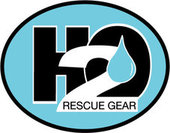Swiftwater rescues in general are ‘high risk’ rescues and in the dark that risk is compounded. Disclaimer - there is more than 7 tips but, I don't want to write a novel! Here are the seven key tips to help your team minimize that risk:
1. Assessment of the scene is even more important at night– especially identifying what is happening downstream.
Assessment of the scene should always be the priority, but in daylight you can possibly see what is going on downstream from the scene itself. However at night that visual goes away. Make sure to go downstream and see what is going on or send a competent, experienced team member down to assess. In moving water, we will most likely find ourselves downstream at some point and you need to know where you can or can not go.
2. Mark the eddys and hazards with chem lights downstream of the rescue
Green Chem lights - Place green chem lights at the upstream side of eddys so rescuers will know where to land a boat or swim to. You can attach the chem lights to overhanging branches or on rocks in clear water bottles filled with water like in the picture below. The water reflects the light making the chem light brighter.
Red Chem Lights – Do not put yourself at risk, but- if possible, add red chem lights to hazards downstream so the rescuers know where NOT to go.
3. Require 2 types of illumination on each responder’s helmet
If you end up in the water the only thing responders on shore will see is the light from your helmet. Each responder should have a headlamp on the front and some type of illuminating device on top like a chem light or battery powered illumination device. If one goes out, you still have a back up light on your helmet to keep you visible. Relying on just a headlamp is too dangerous…they can break, run out of batteries, or just stop working and they will! The picture below shows a variety of headlamps and illumination devices for helmets.

The first helmet is using the Princeton Tec Tactical Quad MPLS Headlamp with V-lites on top.
Middle helmet is using the Princeton Tec EOS Tactical Headlamp with Nite Ize LED Mini Glowsticks.
The helmet on the end is using the Petzl Pixa III Headlamp with a chem light on top.
*Side note – a strobe is also another essential tool for night ops in case of a mayday call. You will want your team to know where you are and nothing says “help” more than a blinking strobe. We prefer the Princeton Tech Meridian Strobe.
4. Keep the victim(s) lit up!

Another piece of gear all responders should carry is a waterproof flashlight like the Princeton Tec Torrent or Tec League lights. We do not want to lose sight of the victim so one responder’s primary job will be keeping light and a visual on the victim(s).
Also keep a chem light attached to the PFD’s you will be handing out to the victim(s). You want it to be high on the shoulder in case they find themselves in the water. This can be pre-rigged.
5. A throw bag is not your best downstream safety.
This is just as important during the day. Don’t expect the victim will catch a throw bag. A tethered rescue or boat-based rescue is a better downstream safety setup option.
6. Diversify and designate your chem light colors, but make sure all team members know what each color is identifying. Here are a few ideas:

Green –
- For rescuers to wear on top of their helmets.
- To place at eddys or landing points on the river where teams can finish the rescue.
Red –
- The color red is usually considered an identifier of danger so I prefer to use it for that - Red chem lights identify hazards downstream
Blue, Orange, Yellow -
- Identifying a certain group of team members – possibly a boat crew, job specific crew (downstream safety, upstream spotter, non water job, victim, etc)
- Invest in cheap waterproof Motorola Radios if you don’t have waterproof comms.
- If throwing a basic Go or Stop sign, possibly hold green chem lights in your hands.
- Taping chem lights below the t-grip of your paddle with electrical tape works and can be used for signaling. You can see this in the picture under number 6.
- Moving your hand back and forth in front of your headlamp or using the blinking mode of your headlamp could be used as a signal.
The Princeton Tec Meridian Strobe has a clear and red light strobe, which could be used for different signals.
In night swiftwater operations it's the little tips and tricks that can be very helpful.
Stay safe!
Aaron


